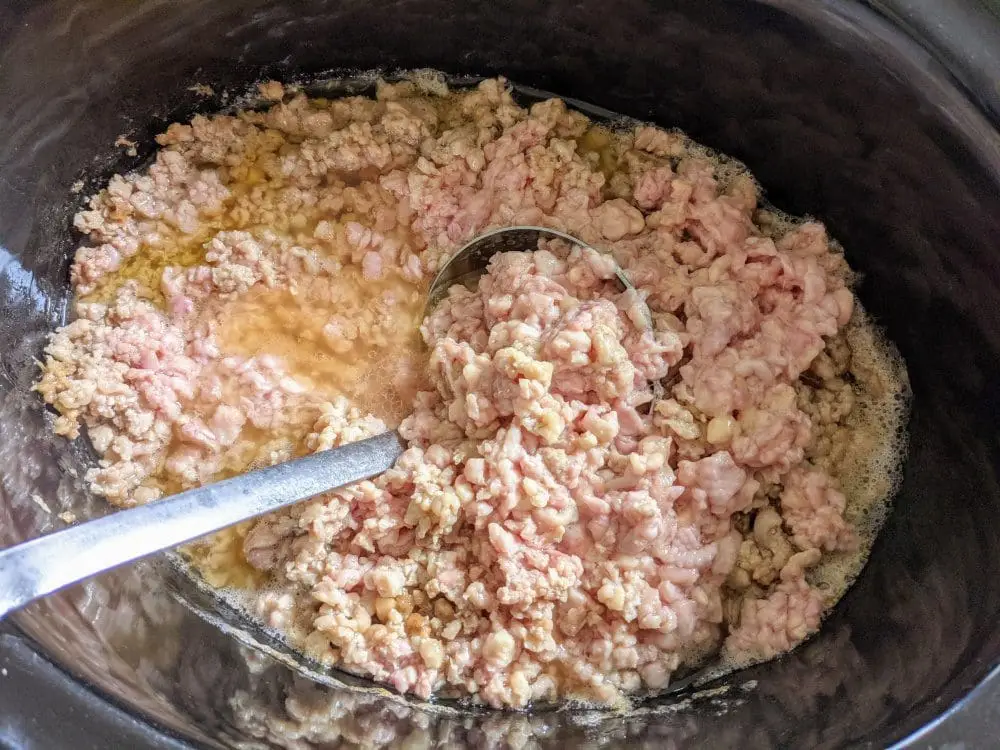Sometimes I go into “test kitchen” mode and crank out batch after batch of the same recipe, trying to get things just right. I’ve been focusing recently on chicken fat and chicken skin.
The subject of eating fat cleaves my audience apart. I get specific inquiries from people looking for lean meat and from others who are looking for fatty meat. But if I have to take a side, my loyalties are to fat. I eat fat, a lot of fat. Beef fat, pork fat, chicken fat, butter, and eggs. I don’t pretend to understand anyone else’s metabolism or daily food needs, but I know that a fat-centric diet suits my body well.
My quest for good fat has taken me to rendering chicken fat. I’ve been trying to find a way to efficiently render chicken fat in large-enough batches that we could sell it in the future. WDF Pasture Raised Schmaltz anyone? Let me know what you think.

We use chicken fat for cooking a vegetable fry-up of greens (like collards or kale), peppers, onions, and mushrooms, a dish that is on frequent rotation in our household. We also use it for frying eggs. And of course there are certain recipes that just aren’t right without chicken fat, like chicken liver pâté or matzo balls.
I grind the chicken skin to speed up the rendering. To render chicken fat I fill a crock pot with chopped chicken skin and simmer it on medium heat for four or five hours, ladling and straining the fat as it appears. When the fat is removed, I’m left with an uninspiring mush that looks like porridge but smells like roasted chicken. But don’t stop here…

This is where the magic happens, as the next phase is taking all those flaccid skins and transforming them into cracklings. I place the skin pieces in a thin layer on a lightly greased cast iron skillet and cook over medium heat, scraping the pan and stirring frequently as the skins brown. Individual pieces start jumping and popping, so I add a cover to the skillet. Once I see a nice brown color I pat the skin pieces dry on a paper towel, and then generously season them. Sometimes I add garlic and paprika, but salt and pepper do quite well on their own. Chicken cracklings are incomparable.
Using ground chicken skin we end up with small crispy bits. Alternatively you can cut the skin into larger squares with scissors or kitchen shears if you want bigger pieces, more like the traditional Ashkenazi gribenes or Filipino chicharones (probably plenty of other food traditions have equivalents, but I haven’t had the chance to eat my way around the world to discover them all).

Interested in making chicken cracklings at home? You can use one of the lowest-cost products we sell: chicken necks. Our necks are packaged with the skin on, but it is quite easy to pull the skin off with one tug. You can prepare the skins as cracklings and have another full meal if you set all the skinless necks aside for a batch of broth.

4 thoughts on “In Praise of Chicken Fat and Skin”
This was my first time rendering chicken fat and skin and I must say that it looks delicious! I find that rendered chicken fat works best with matzoh balls and chopped liver. I’m working on the “cracklings” as I type this and looking forward to tasting them!
Sounds tasty!
If I cook skin and bones to make a fatty broth for soup, is this fatty enough for the carnivore diet?
Mary, there are a lot of carnivore gurus out there, and I get the impression that they disagree about broth.
My experience is that I can’t go out and do a hard day’s work on broth alone. But it makes a nice minor addition to my diet. Rachel, however, gets a fair amount of her daily nourishment from chicken and beef broth, so it’s clearly been effective for her.
It seems to me that all our bodies are tuned to respond to foods differently, so I’m reluctant to make any broad statements about how anyone else should be constructing their complete diet.